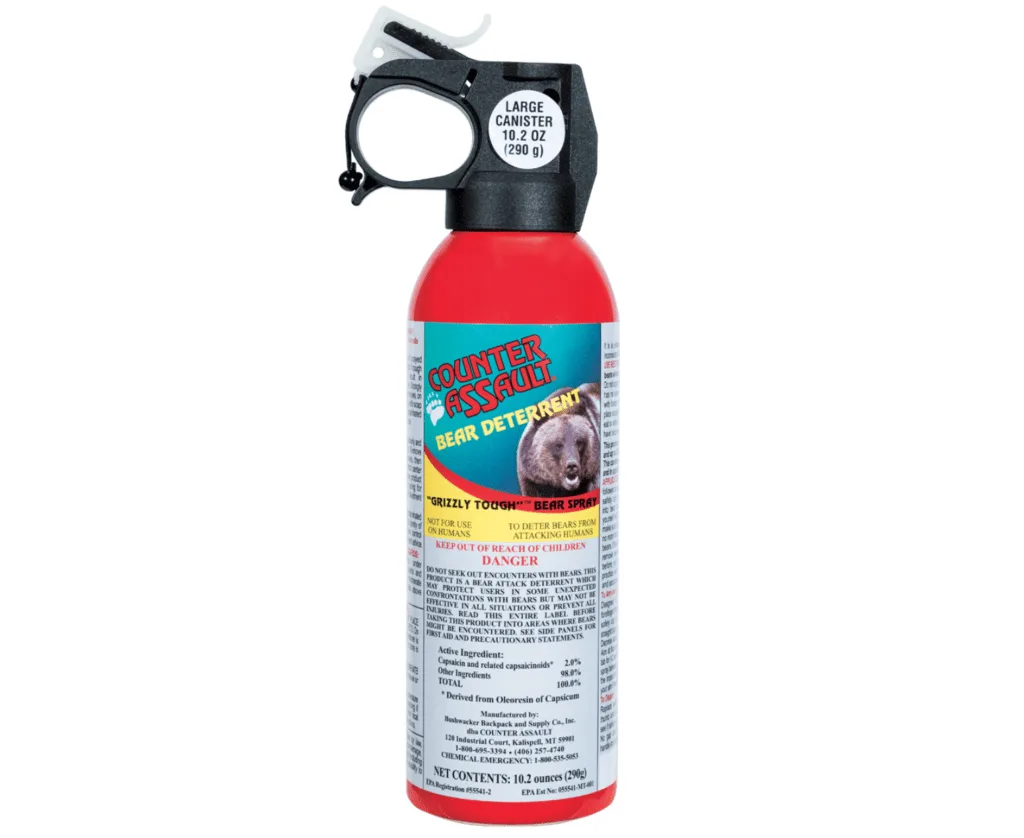The Best Deals on Camping, Backpacking and Outdoor Gear [June 2025]
Watch this video directly on YouTube.
I know, I know. When we first learned that Counter Assault bear spray was more eco-friendly, we were all, whaaaat? Can bear spray even be NON environmentally friendly? So we dug in to learn more. Here’s what we found.
Eco-Friendly Bear Spray
First things first. A few deets about Counter Assault bear spray: it’s the only brand that can spray up to 40ft. That’s not a sustainability feature, but since most sprays only spray up to 30 feet, it’s worth mentioning. I mean, personally, if I’m going to have to spray a charging grizzly in the face, I would much rather it be 40 feet away from me than 30.
Plus, it was developed in conjunction with the University of Montana by a grizzly bear encounter survivor, so that’s something. “Experience makes the best teacher” and all that.
As for sustainability, the spray is registered with the EPA and is a 1998 recipient of the IGBC Stewardship Award for Research and Development of Bear Pepper Spray (the only bear spray company who can claim this). Plus, they’re the only company to comply with the EPA’s Clean Air Act’s Significant New Alternatives Policy (SNAP) requirements (and its equivalence in Canada, which is new as of this year), which relates to ozone-depleting substances.
Secondly, the brand’s spray reduces global warming potential by 90% compared to other bear sprays! Ninety percent! This is because of Counter Assault’s new formulation; all the other bear sprays on the market can’t make this claim because they use the ingredients from an old formula (that Counter Assault also used at one time–the next section will break this down in more detail).
What does this all mean? Counter Assault bear spray is a heckuva lot better for the environment than it used to be, that’s what it means. According to the EPA, the average passenger vehicle emits about 4.6 metric tons of CO2 per year. The global warming potential (GWP) of one ton of CO2 = 1. Therefore, the GWP of the average passenger vehicle is 4.6. When Counter Assault changed their formula, they reduced their GWP from 1,300 to 138, (!!!) that’s equivalent to removing 252 passenger cars from the road per year.
But what chemicals are involved and how does it all work? Keep reading, ya science nerd.

Want to Get Even More Science-y?
Here’s what the team over at Counter Assault has to say about it:
The old formula (and most other bear spray brands) used a chemical known as Freon. Yes, the same stuff in your car or home’s AC unit. Freon is a hydrofluorocarbon or HFC. Gases in this family have a massive global warming potential that ranges from 1000-3000x that of carbon dioxide (CO2) depending on the chemical/gas.
And their use has grown substantially over the last two decades, resulting in roughly 1% of global greenhouse gas emissions, with the majority coming from developed countries (as you might expect since it’s used for air conditioning). So naturally, the impact of HFCs on the climate has led to widespread efforts to reduce their use.
In fact, the United Nations Framework Convention on Climate Change (UNFCCC) under the Kyoto Protocol identified HFCs as one of the major 6 greenhouse gases that must be reduced and the EPA in the U.S. launched the Significant New Alternatives Policy Program (SNAP) under the Clean Air Act to reduce their use in federal agencies back in 2016.
Individual States have even adopted or introduced rules modeled after SNAP, including California, Oregon, Washington, Colorado, Maine, Vermont, New York, Massachusetts, New Jersey, Maryland, Delaware, Virginia, Pennsylvania, Connecticut, and Rhode Island.
As for the new formula, it ditches freon in favor of Difluoroethane, which can be used in a similar manner as Freon, but it has a much lower global warming potential at 124-138x that of CO2 (even though it’s still an HFC–but not an ozone-depleting gas).
That science-y enough for ya?

Bottom Line
In short, yes, more eco-friendly bear spray does exist. It’s still not harmless when it comes to sustainability, but bear spray is a necessary survival tool when you’re in grizzly country. How can you make it even more sustainable? See if you can rent it instead of buy it once you arrive at your destination (some parks and outdoor stores offer this service). Or pass your unused canister on to someone else before you leave (you can’t take it on an airplane and it does have an expiration date).
Both ways keep an excessive amount of full, unused canisters out of the landfill and keep more from having to be manufactured. That said, if you do need to buy a canister or two, find them at REI.
And remember: firearms still aren’t a better choice. Statistically speaking, you’re twice as likely to be injured by a bear if you use a gun as opposed to bear spray.
So gear up, get out there, choose a more sustainable bear spray for adventures in grizzly country, and wander on.
This post contains affiliate links, which means purchases you make after clicky-clicking may help support Terradrift! But don’t worry! You won’t pay a dime more for your dope new gear.
